The first person to spot a clown, the patient zero in the current epidemic of threatening clowns sightings spreading across the US, was a little boy at a low-income apartment complex in Greenville, South Carolina.
He ran to his mother, Donna Arnold, and told her what he had seen: two clowns in the woods, both brightly dressed and made up. One with a red fright wig and the other with a black star painted on his face. They whispered something to the boy.
“They were trying to lure him to the house,” his mother told me, pointing toward the woods.
A path into the woods led down into a shaded hollow, at the bottom of which was a small pond. Beside it sat a house that seemed abandoned. Someone had boarded up the windows, and the balcony sagged. New bags of potting soil sat near the basement door, though. And a modern security system looked recently installed.
After sunset a car approached the house; a gleaming white, new-model Mercedes that looked as out of place as any clown car. The driver stepped out and said she had recently bought the old house as an investment because it sits on five acres in an otherwise densely populated area. “You think it looks bad now, you should have seen it before I came in,” she said.
While we talked she wore an in-ear headset, so it wasn’t always clear whether she was speaking to me or someone on her phone.
No, she didn’t want to give her name, she said.
This article includes content provided by Facebook. We ask for your permission before anything is loaded, as they may be using cookies and other technologies. To view this content, click 'Allow and continue'.
Yes, she had heard about the clown sightings.
She gestured toward the apartment complex through the trees. “Every one of them has a phone, and can work it better than I can,” she said. “And yet there’s not a single video of a clown?”
I followed the path back to deliver the good news to Donna Arnold. The clowns weren’t real.
“Ha!” she said. One sharp stab of laughter. “Come around to the back.”
Her apartment backed up to the same patch of overgrown woods where the clowns had appeared. Arnold pointed to a dented spot in her door where the paint had recently been chipped away. “The clowns hit it with a chain,” she said, with complete conviction. “I saw them. They hit it and ran off into the woods just as I came out. They’re trying to scare us.”
From this patch of woods, the word of prowling clowns began to spread. On the other side of Greenville, first. Then down in South Carolina’s low country. Then North Carolina. Florida. Kentucky. Beyond the south to Pennsylvania, Wisconsin, New York.
And, finally, my little girl’s school.
Nobody laughs at clowns any more.
Maybe antiquated proto-clowns did make people smile. But the legendary Chinese jester Yu Sze and the imperial Roman stupidus would be unrecognizable to us today.
The first clown who fits our description – painted face, frilly collar – was Joseph Grimaldi, who entertained Londoners in the 19th century but had a decidedly dark side. “I am Grim-all-day,” he told people.
A young Charles Dickens ghost-wrote Grimaldi’s memoirs, a saga of abuse, addiction and agony. “A tale of unmitigated suffering, even when that suffering be mental, possesses but few attractions for the reader; but when, as in this case, a large portion of it is physical,” Dickens wrote, it “grows absolutely distasteful”.
Dickens recognized, even with the very first modern clown, that what fascinates us is not the exaggerated painted face, or the dull face of a man underneath. It’s the tension between the two. The dissonance between what is and what appears to be.
That conflict plucks at some ancient strand of human genetic code.
“Since caveman days, people would smear ashes on their faces to make each other laugh,” said David Kiser, a talent recruiter for Ringling Bros circus company. “Other times they would smear ashes on their faces to scare each other.”
I recently received an automated call from my daughter’s school, in Fairhope, Alabama. It was intended to calm parents, but the missing details spoke more sharply than the ones included.
“Hi, this is Fairhope middle school calling with an important message,” the cheerful voice began. “Please rest assured that your students are safe and the school is taking necessary precautions due to rumored activity. The school perimeter is secured and the police are on campus.”
The call was meant to prevent worried parents from calling the school.
I called. The woman who answered hesitated to describe what had happened.
“Well, it’s …” she said. “It’s the clowns.”
Apparently the alarm had started in a neighboring county, where two schools had gone into lockdown after disturbing threats from someone calling himself Flomo Klown.
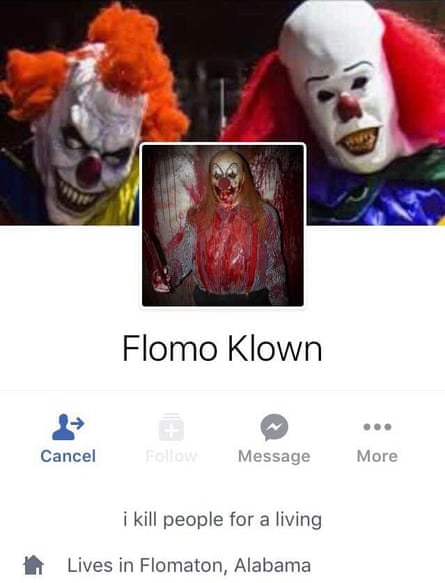
Flomo had a Facebook page. The profile picture showed a balding clown with red, stringy hair and a rubber nose. His shirt was drenched in blood. His bio read simply, “I kill people for a living.”
Flomo made posts targeting a specific town – Flomaton, Alabama – along with more gory clown photos and little gun and knife emojis.
People, in a word, flipped out.
“I rebuke this evil in the NAME of JESUS!!!! YOU are from the Pits of Hell!” a local woman wrote on Flomo’s page. “Everyone let us pray as believers over this act of evil against us.” She immediately followed through by writing a lengthy, heartfelt, terrified Facebook prayer.
Some people appealed to heaven. Some speculated on the best ammunition to bring down a clown. Some advocated restraint – maybe just paint balls? – and others reached for .45-caliber pistols.
All of it might seem silly but something about the arched eyebrows and garish smile skipped a signal right to the base of people’s brains.
They had lost all capacity for critical thought.
People in Flomaton don’t go in for subtext. Their town sits on the Florida-Alabama state line, so they named it after “Florida” and “Alabama” and “town”.
Long ago it served as a railroad hub for timber, but its population has since dwindled to 1,400 people who work at Flomaton high school, Wadkins autos or the old train museum. People are polite. Most attend one of several churches. And, it turns out, they don’t tolerate blood-soaked clowns.
After Flomo’s scary posts, police locked down the schools and swept classrooms for clown-related evidence.
Within minutes the fear spread to other schools, particularly middle schools, where kids were old enough to access social media but still young enough to hyperventilate over clowns.
Sociologist Robert Bartholomew at Botany College in New Zealand has studied mass hysteria for decades, and said the current clown scare is a result of two rising forces in the US: social media, and a fear of otherness, whether it arrives in a white Mercedes or a refugee boat.
“Social media plays a pivotal role in spreading these rumor-panics which travel around the globe in the blink of an eye,” he said. “They are part of a greater moral panic about the fear of strangers and terrorists in an increasingly urban, impersonal, and unpredictable world.”
That afternoon back in my town, Fairhope, students sprinted through the hallways from one classroom to the next. In class they stared at cellphones and traded stories about how Flomo Klown had killed two boys in Flomaton, and was now moving from school to school.
“Good grief,” teacher Kendra Small said. “Please save me from being trapped in a school with middle schoolers who are sure that clowns are coming to get them.”
It started as a satisfying teenage drama, but spiraled into something serious enough to warrant calling the police to make sure the “perimeter is secured”.
Later, I showed my 13-year-old daughter a picture of a young woman.
“Who is this?” she said.
Police say that’s Flomo Klown, I told her. Her real name is Makayla Smith, she’s 22, and police in Flomaton arrested her and two juveniles for allegedly making “terroristic threats” as Flomo.
My daughter studied the photo with forensic intensity, almost touching it with her nose. “But she seems like a normal person,” she said.
The man who answered the door at Smith’s last known address said he didn’t know her, and Smith is banned from using any internet-capable electronics while she’s on bond. Her friends didn’t respond to requests for help reaching her. But her Facebook page outlines clearly enough a life beginning to spin.
In September she posted a picture of a positive pregnancy test, and a block of enigmatic text:
“Well everyone I have some news to announce, it’s scary yet exciting. It looks like around May 2017 I’ll have a little one of my own. Reason I say it’s scary is because of what happened in 2011 after that I really thought I couldn’t have anymore. I’m so nervous about this but I will be taking things day by day. Please don’t judge or say anything out of the way.”
Two days later she allegedly created the Flomo Klown persona and posted, “I love kids.”
Reports of scary clowns have come and gone every few years. This time, though, the rumors seem to have reached such a velocity that they have escaped the orbit of imagination and landed in real life.
In Kentucky, police recently arrested a 20-year-old man hiding in a ditch, wearing a clown costume. Police in Virginia arrested two teens for wearing clown outfits and chasing children. Meanwhile police in Winston-Salem, North Carolina, arrested a man for falsely claiming he had seen a clown trying to lure children and chased it into the woods. He had made it all up, he told police.
It’s a tough moment for clowns. But David Kiser, Ringling Bros’ clown expert, said they will never disappear completely.
“They will have to evolve,” he said. “But clowns hold up a mirror on society, so we can see the absurd in ourselves. So to be afraid of them is ultimately to be afraid of yourself.”
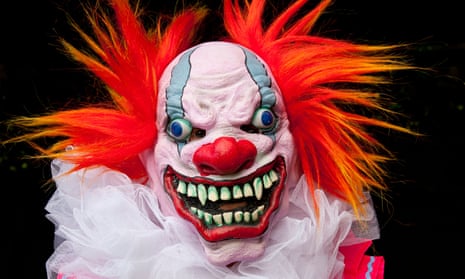


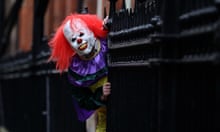
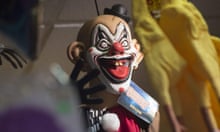



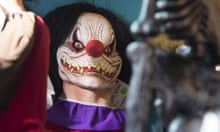
Comments (…)
Sign in or create your Guardian account to join the discussion